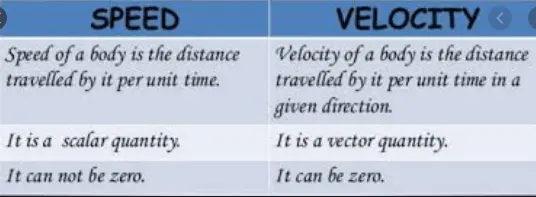Difference Between Speed and Velocity with Examples


Speed and velocity are terms in motion. These are two different physical quantities. Speed is the distance covered by a body in unit time. It is a scalar quantity. While velocity is the displacement covered by a body in unit time. It is a vector quantity.
In this post, you are going to differentiate b/w Speed and velocity in detail.
If you want to get benefits from this post you’ll love this post.
Keep reading…
Speed and velocity are terms used as synonyms to refer to the relationship between the distance traveled and the time is taken to cover it.
However, speed and speed do not always refer to the same thing. In more specialized fields, such as physics, they have slight differences.
The speed refers to the distance traveled by an object in a time determined. Since this is calculated by taking the distance traveled and dividing it by time, speed is a scalar magnitude.
Instead, velocity refers to the time interval it takes for an object to move in a certain direction. By involving the direction or sense of movement, speed is a vector quantity.
What is speed?
The speed indicates the relationship between the distance traveled by an object and the time that this used to cover it. As such, it can be measured in meters, kilometers, miles, or knots (in the water environment), per hour, or per second.
Since speed is expressed according to distance and time, it is characterized by being a scalar quantity, which means that only numerical units are used to describe speed.
Since speed implies covering a distance during a time interval, it can only give a positive value.
Speed characteristics
- Consider the distance traveled and the time elapsed.
- It is a scalar magnitude.
- Average speed results from the division between distance and a time interval.
- It is always positive.
Average speed
Average speed refers to the total distance traveled during a given time.
For example, when Usain Bolt set the world record for 100 flat meters in 9.58 seconds, his average speed was 10.44 meters per second.
What is velocity?
The rate expresses the ratio between the distance traveled by an object and the time it takes you to cross it towards a direction-specific.
Basically, speed refers to the positional change of an object, from an initial reference point to the place to which this object has moved (the endpoint of movement), and to the time it has taken to do so.
Being a magnitude that also determines the direction in which the displacement occurs, the velocity is considered a vector magnitude.
Speed is measured in meters per second (m / s, according to the International System of Units), by direction.
In this sense, for an object to have a constant speed, it must move in a constant direction for a certain amount of time. Any change in direction will simply be variations in speed.
Speed characteristics
- Consider changing the position of an object in a specific direction.
- It is a vector quantity.
- The average speed involves the displacement between the time interval.
- You can give a positive, negative, or even null (zero) value.
Difference between speed and velocity in tabular form
| Speed | Velocity |
| Speed is the distance covered by a body in unit time. | Velocity is the displacement covered by a body in a unit of time. |
| It is a scalar quantity. | It is a vector quantity. |
| It Determines “How fast an object is moving”? | It determines “In which direction an object is moving”? |
| It indicates the rapidity of objects. | It indicates both the rapidity and position of the object. |
| It is the rate of change of distance. | It is a rate of change of displacement. |
| It cannot be negative. | The velocity of moving Objects can be negative, positive or can be zero. |
Speed Vs Velocity
Related topics
Related Post
Recent Posts
Is energy quantized in classical physics?
No, according to classical wave theory the emission of electromagnetic radiations from the surface is…
Types of laser
Basically, there are four types of laser which includes: Gas Lasers Solid State lasers Liquid…
Ultrasound frequency range
What is ultrasonics? The study and application of mechanical vibrations with frequencies beyond the limits…
Electromagnetic Energy: What are some examples of it?
Electromagnetic energy definition Electromagnetic energy is the amount of energy stored in a region of…
Fundamental units and Derived Units with Examples
The Main Difference between fundamental Units and Base units is that Units that Express base…
Newton’s First law of Motion Examples in Our Daily Life
Newton's first law of motion states that " A body continues its state of rest…
View Comments
Thanks so much for the answer.
Speed and velocity are as.to if the star was to be stared the figured of speed that the star gets to it's point of about is the velocity of the strength of the stars out put of fire that may be stronger than man thinks.
Thanks so much for the answer you are so smart.
point a to point a is zero velocity got it.......... point a to point b is what velocity...no not speed.
It was well summarize and more interesting on it.